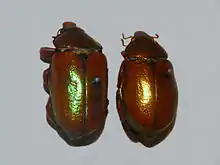Anoplognathus viridiaeneus
Anoplognathus viridiaeneus, commonly known as the king Christmas beetle, is a beetle of the family Scarabaeidae native to eastern Australia. The largest Christmas beetle, it can be over 3 centimetres (1.2 in) long.
| Anoplognathus viridiaeneus | |
|---|---|
 | |
| Male (left) and female (right) A. viridiaeneus from Australia | |
| Scientific classification | |
| Kingdom: | Animalia |
| Phylum: | Arthropoda |
| Class: | Insecta |
| Order: | Coleoptera |
| Family: | Scarabaeidae |
| Genus: | Anoplognathus |
| Species: | A. viridiaeneus |
| Binomial name | |
| Anoplognathus viridiaeneus (Donovan, 1805) | |
| Synonyms | |
| |
Taxonomy
Edward Donovan described the King Christmas beetle in 1805 as Melolontha viridi-ænea, writing, "Nature seems to have devoted abundant attention to the embellishment of this common insect: its glow of colouring is peculiar and inimitable. The prevailing hues do not strictly please us by their harmony as their contrast, which is indeed striking, or rather glaring, but upon the whole produce a rich effect", describing it as "testaceous" (red-brown) overlain with translucent green and a brassy-gold sheen in light.[1] Its specific epithet is derived from the Latin words viridis "green" and aeneus "copper/bronze".
The King Christmas beetle was described in 1817 as Rutela caesarea by Gustaf Johan Billberg and R. latreillei by Leonard Gyllenhaal.[2]
When Leach erected the genus Anoplognathus in 1815, he did not assign a type species. Phil Carne designated A. viridiaeneus as the type in 1957.[3]
Description
The largest Christmas beetle, the adult male is 30–32 mm long and 16–19 mm wide at its broadest, while the female is 28–34 mm long and 16-19.5 mm wide. It is predominantly red-brown with gold-green overtone. The head has rose highlights, while the pronotum, scutellum and elytra have a gold sheen. The pygidium, coxae, and abdomen are a bright green, while the legs are red-brown, and tarsi are black. The female has flatter elytra than the male.[3]
Distribution
This species is present in eastern Australia (New South Wales and Queensland).[2] Once common around Sydney, it has all but vanished due to loss of habitat.[4][5]
Ecology
The larvae feed on rotting wood, humus and grass roots.[2]
The King Christmas beetle has been recorded on the turpentine tree (Syncarpia glomulifera) of the family Myrtaceae.[3]
References
- Donovan, Edward (1805). An Epitome of the Natural History of the Insects of New Holland, New Zealand, New Guinea, Otaheite, and other Islands in the Indian, Southern, and Pacific Oceans: including Figures and Descriptions of One Hundred and Fifty-three Species of the more Splendid, Beautiful, and Interesting Insects, hitherto Discovered in those Countries, and which for the most Part have not appeared in the Works of any Preceding Author. London: Rivington. p. 3.
- Australian Biological Resources Study (14 October 2013). "Species Anoplognathus viridiaeneus (Donovan, 1805)". Australian Faunal Directory. Canberra, Australian Capital Territory: Department of the Environment, Water, Heritage and the Arts, Australian Government. Retrieved 15 December 2015.
- Carne, P.B. (1957). "A revision of the ruteline genus Anoplognathus Leach (Coleoptera: Scarabaeidae)". Australian Journal of Zoology. 5 (1): 88–144. doi:10.1071/ZO9570088.
- Hawkeswood, Trevor J. (2007). "Beetles (Coleoptera) of the Shell Picture Card series: Scarabaeidae" (PDF). Calodema (Supplementary Paper No. 49): 1–6. Archived from the original (PDF) on 2015-12-22.
- Reid, Christopher (16 January 2012). "Where have all the Christmas Beetles Gone?". Retrieved 21 December 2015.
External links
- Andrew Smith Checklist of the world Anoplognathini